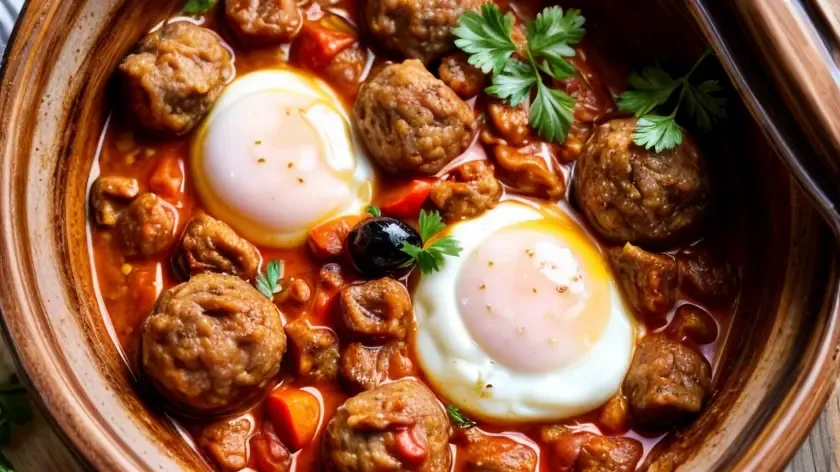Welcome to the world of Moroccan Lamb Tagine, where every bite tells a story of heritage, spice, and culinary mastery. Lamb Tagine is more than just a dish—it’s a celebration of Morocco’s rich culture and time-honored cooking traditions. Slow-cooked to perfection in a traditional clay pot, this iconic dish combines tender lamb with aromatic spices, seasonal vegetables, and a symphony of flavors that will transport your senses to the heart of Morocco.
From the classic Lamb Tagine with prunes and almonds to the savory Lamb Tagine with apricots and honey, this page is your ultimate guide to exploring the diverse and delicious world of Moroccan Lamb Tagine. Whether you’re a seasoned chef or a curious food lover, you’ll find everything you need to master this beloved dish, including authentic recipes, expert tips, and the cultural significance behind each variation.
Get ready to embark on a culinary adventure that will inspire your kitchen and delight your taste buds. Let’s dive into the magic of Moroccan Lamb Tagine—where tradition meets flavor in every spoonful.

Lamb Tagine with Potatoes
A classic Moroccan dish featuring tender chicken, green olives, and preserved lemons.
View Recipe
Beef Tagine with Peas and Artichokes
Sweet and savory, this tagine combines succulent lamb with prunes and almonds.
View Recipe
Tagine of Lamb with Prune and Almonds
Rich and flavorful, this tagine features beef, peas, and artichokes.
View Recipe
Tajine of Lamb Shoulder with Onions and Raisins
A coastal delight with fresh fish marinated in chermoula sauce.
View Recipe
Kefta Tagine with Eggs
Spiced meatballs cooked in a rich tomato sauce and topped with eggs.
View Recipe.png)
Meat Tagines: Explore a variety of delicious and authentic Moroccan meat tagine recipes, each with its own unique flavor and aroma.
Discover the flavors: From classic lamb tagines to hearty and flavorful beef stews, find the perfect meat tagine recipe to suit your taste.
Easy to make: All of our meat tagine recipes are easy to follow and can be made with readily available ingredients.
Perfect for any occasion: Whether you're looking for a quick and easy weeknight meal or a special dish to impress your guests, our meat tagine recipes are sure to please.
Meat Tagine: A Hearty Moroccan Dish
History of Meat Tagine:
Ingredients in Meat Tagine:
Cooking Meat Tagine:
Serving Meat Tagine:
Popularity of Meat Tagine:
Meat tagine is a delicious and hearty dish that is easy to make. It is a good source of protein and vitamins, and it is a great way to experience Moroccan cuisine.
some additional information about meat tagine:
- Meat tagine is a relatively healthy dish, as it is low in fat and calories.
- Meat tagine is a good source of protein, which is essential for building and maintaining muscle mass.
- Meat tagine is also a good source of vitamins and minerals, including vitamin A, vitamin C, and potassium.
- If you are looking for a delicious and healthy Moroccan dish to try, meat tagine is a great option.
some popular meat tagine recipes:
- Classic Lamb Tagine with Prunes and Almonds: This traditional Moroccan dish is made with lamb, prunes, almonds, and a blend of spices.
- Beef Tagine with Tomatoes and Peppers: This hearty and flavorful tagine is made with beef, tomatoes, peppers, and a blend of spices.
- Chicken Tagine with Apricots and Almonds: This sweet and savory tagine is made with chicken, apricots, almonds, and a blend of spices.
Significance of Meat Tagine in Moroccan Culture and Geography Cultural Significance
- Symbol of Hospitality: Tagines are often served as the centerpiece of meals, especially when hosting guests. The elaborate presentation and communal sharing of the dish reflect the importance of welcoming others and fostering a sense of togetherness.
- Community Gatherings: Tagines are a staple in communal gatherings, such as weddings, celebrations, and religious holidays. The preparation of tagines often involves multiple individuals, highlighting the collaborative spirit and shared values of Moroccan communities.
- Cultural Identity: The unique flavors, aromas, and cooking techniques associated with meat tagines are deeply intertwined with Moroccan identity. The dish serves as a culinary emblem of the country's heritage, passed down through generations.
Geographical Significance
- Diverse Agricultural Landscape: Morocco's varied terrain, ranging from fertile coastal plains to rugged mountains, supports a diverse agricultural landscape. This abundance of land allows for the cultivation of a wide range of vegetables, fruits, and herbs that are essential ingredients in tagines.
- Livestock Farming Tradition: Morocco has a long tradition of livestock farming, raising sheep, goats, and cattle. This abundance of locally sourced meat provides the primary protein component for tagines, ensuring freshness and authenticity.
- Spice Trade Routes: Morocco's historical role as a hub along spice trade routes granted access to a vast array of spices, such as cumin, coriander, ginger, and saffron. These aromatic ingredients have become indispensable in Moroccan cuisine, adding depth and complexity to tagine dishes.
Meat tagines hold immense cultural significance in Morocco, representing hospitality, community, and culinary heritage. The country's unique geographical location and diverse agricultural landscape have played a crucial role in shaping the development of this iconic dish.












%20(1).webp)
.webp)


.webp)

